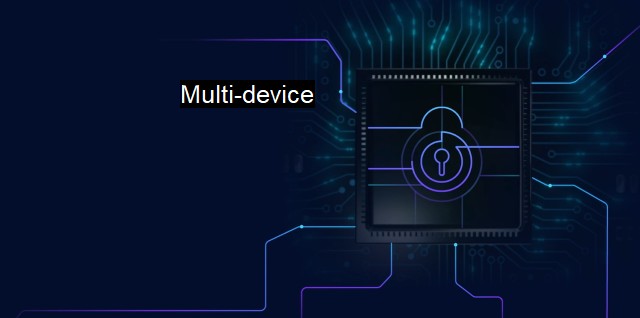What is Multi-device?
Uncovering the Threats of Multi-Device Culture: Safeguarding Sensitive Information in the World of Technology
In the realm of cybersecurity and antivirus protection, the term "multi-device" is becoming increasingly important as the majority of people now rely on multiple electronic devices in their day-to-day life. This relatively new trend has directly influenced the digital security landscape, as it prompts cybersecurity specialists to develop advanced solutions that can ensure enhanced protection across several platforms or devices simultaneously.Multi-device, in the simplest terms, means that software or a service is designed to function across multiple electronic devices. The implication of this within the cybersecurity space couldn't be more significant. A multitude of interconnected devices demands an equal stretch of protection measures that can work on several platforms seamlessly.
The concept of a multi-device antivirus and cybersecurity system extends its protection across a wide range of devices like computers, smartphones, tablets, and other internet-connected devices that the individual or organization uses. This diversity requires a more complex level of security, which delves into the unique vulnerabilities and features of each device, thus ensuring optimal protection for all of the user’s various devices.
Before the multi-device approach to cybersecurity and antivirus software, users typically had to install and manage separate security software for each device. Each of these software variants could have different user interfaces, subsequently complicating the overall user experience. The advent of multi-device software streamlined this process, enabling users to manage the security settings of all their devices from a single platform.
Multi-device protection is currently a necessity due to the rise of different types of cyber threats. Generally, cyber threats that target computers differ from those that target mobile devices. Phishing, which involves tricking users to reveal private information, can occur across all these platforms, albeit in various forms reflecting each platform’s specific vulnerabilities. Also, with the increasing use of IoT devices, the risk perimeter for an individual or an organization has greatly expanded and underscores the need for comprehensive multi-device protection.
The functionality of multi-device antivirus is broad and adept. It scans for malware—infectious software designed to harm electronic devices or extract sensitive information—it also checks for security weaknesses, provides safe browsing options, and even gives warnings about suspicious links. These functionalities usually remain consistent across devices, making multi-device software user-friendly.
The emphasis on the use of cloud technologies fundamentally advances the architecture of multi-device antivirus. Leveraging cloud technologies allows the data or the security status of each device to be synchronized and updated in real time. Depending on the software, some services can also be centrally controlled. This feature further ensures that all devices under its network are protected according to standardized, pre-determined settings.
The term 'multi-device' in cybersecurity symbolizes the rapid evolution and centralization of antivirus protection. With the rise of interconnected digital existence, the widespread use of several types of devices, and no signs of slowing down, the demand for reliable multi-device cybersecurity solutions will only continue to grow. Security does not solely pertain to one's laptop or mobile phone anymore. It encompasses all devices in use, extending to our diversified digital engagements. Thus, understanding and utilizing multi-device antivirus tools is a crucial component for digital survival in the modern interconnected world.

Multi-device FAQs
What is multi-device antivirus?
Multi-device antivirus is a cybersecurity solution that can be used across multiple devices. It provides protection against viruses, malware, and other online threats for all devices in a network or linked to a single account.What types of devices can be protected by multi-device antivirus?
Multi-device antivirus can protect a range of devices including smartphones, tablets, laptops, desktops, and even smart home devices. It provides comprehensive protection across all devices in a network.How does multi-device antivirus work?
Multi-device antivirus software works by continuously monitoring incoming data and activities on all devices connected to a network. It identifies potential threats and alerts the user when necessary. It also updates itself regularly to stay up-to-date with the latest security threats.What are the benefits of using multi-device antivirus?
The key benefits of using multi-device antivirus are that it provides comprehensive protection against online threats across all devices in a network, reduces the need for multiple antivirus subscriptions, and simplifies the management of cybersecurity across multiple devices. Additionally, multi-device antivirus enables users to protect their digital assets from multiple angles, making it less likely for cybercriminals to penetrate a user's security protocols.Related Topics
Multi-device protection Unified threat management (UTM) Mobile device security Internet of Things (IoT) security
| | A | | | B | | | C | | | D | | | E | | | F | | | G | | | H | | | I | | | J | | | K | | | L | | | M | |
| | N | | | O | | | P | | | Q | | | R | | | S | | | T | | | U | | | V | | | W | | | X | | | Y | | | Z | |
| | 1 | | | 2 | | | 3 | | | 4 | | | 7 | | | 8 | | |||||||